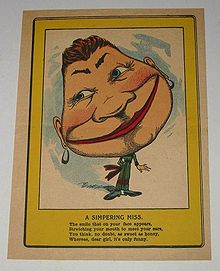This is an old revision of this page, as edited by 98.87.71.208 (talk) at 04:23, 14 February 2010 (added sources and text about post masters). The present address (URL) is a permanent link to this revision, which may differ significantly from the current revision.
Revision as of 04:23, 14 February 2010 by 98.87.71.208 (talk) (added sources and text about post masters)(diff) ← Previous revision | Latest revision (diff) | Newer revision → (diff)| This article does not cite any sources. Please help improve this article by adding citations to reliable sources. Unsourced material may be challenged and removed. Find sources: "Vinegar valentines" – news · newspapers · books · scholar · JSTOR (February 2007) (Learn how and when to remove this message) |

Vinegar valentines are greeting cards, or, rather, insult cards, that come in the form of an insult, decorated with a caricature and, below that, an insulting poem. Ostensibly given on Valentine's Day, the caricature and poem is about the "type" that the recipient belongs to--spinster, floozy, dude, scholar, etc.
The cards are usually simply a sheet of thin, colored paper, about the size of a modern greeting card. They were later also produced in the form of postcards. They were usually sent anonymously. Postmasters sometimes confiscated these cards as unfit to be mailed.
The cards were first produced in the late Victorian era and enjoyed their greatest popularity in that period and in the first quarter of the 20th century.
Some people mistakenly call them penny dreadfuls, although that term in fact refers to a form of potboiler fiction.
One pop culture reference to vinegar valentines is found in Bill Watterson's Calvin and Hobbes comic strip. Calvin often gives Susie Derkins vinegar valentines so as to hide his true affections for her under a veil of immature distaste. New Jersey On-Line LLC.
This culture-related article is a stub. You can help Misplaced Pages by expanding it. |